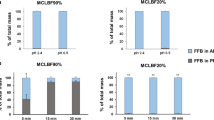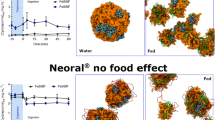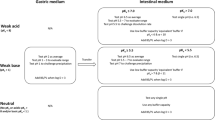Abstract
Purpose
The overall purpose of this study was to understand the impact of different biorelevant media types on solubility and crystallization from supersaturated solutions of model compounds (atazanavir, ritonavir, tacrolimus and cilnidipine). The first aim was to understand the influence of the lecithin content in FaSSIF. As the human intestinal fluids (HIFs) contain a variety of bile salts in addition to sodium taurocholate (STC), the second aim was to understand the role of these bile salts (in the presence of lecithin) on solubility and crystallization from supersaturated solutions,
Methods
To study the impact of lecithin, media with 3 mM STC concentration but varying lecithin concentration were prepared. To test the impact of different bile salts, a new biorelevant medium (Composite-SIF) with a composition simulating that found in the fasted HIF was prepared. The crystalline and amorphous solubility was determined in these media. Diffusive flux measurements were performed to determine the true supersaturation ratio at the amorphous solubility of the compounds in various media. Nucleation induction times from supersaturated solutions were measured at an initial concentration equal to the amorphous solubility (equivalent supersaturation) of the compound in the given medium.
Results
It was observed that, with an increase in lecithin content at constant STC concentration (3 mM), the amorphous solubility of atazanavir increased and crystallization was accelerated. However, the crystalline solubility remained fairly constant. Solubility values were higher in FaSSIF compared to Composite-SIF. Longer nucleation induction times were observed for atazanavir, ritonavir and tacrolimus in Composite-SIF compared to FaSSIF at equivalent supersaturation ratios.
Conclusions
This study shows that variations in the composition of SIF can lead to differences in the solubility and crystallization tendency of drug molecules, both of which are critical when evaluating supersaturating systems.









Similar content being viewed by others
Abbreviations
- FaSSIF:
-
Fasted state simulated intestinal fluid
- HIF:
-
Human intestinal fluid
- J amorph :
-
Flux at amorphous solubility
- NIT:
-
Nucleation induction time
- SGC:
-
Sodium glycocholate
- SGCDC:
-
Sodium glycochenodeoxycholate
- SGDC:
-
Sodium glycodeoxycholate
- SGUDC:
-
Sodium glycoursodeoxycholate
- SIF:
-
Simulated intestinal fluid
- SR :
-
Supersaturation ratio
- SR amorph :
-
Supersaturation ratio at amorphous solubility
- STC:
-
Sodiun taurocholate
- STCDC:
-
Sodium taurochenodeoxycholate
- STDC:
-
Sodium taurodeoxycholate
- STUDC:
-
Sodium tauroursodeoxycholate
References
Newman A, Knipp G, Zografi G. Assessing the performance of amorphous solid dispersions. J Pharm Sci. 2012;101(4):1355–77.
Van den Mooter G. The use of amorphous solid dispersions: a formulation strategy to overcome poor solubility and dissolution rate. Drug Discov Today Technol. 2012;9(2):e79–85.
Anby MU, Williams HD, McIntosh M, Benameur H, Edwards GA, Pouton CW, et al. Lipid digestion as a trigger for supersaturation: evaluation of the impact of supersaturation stabilization on the in vitro and in vivo performance of self-emulsifying drug delivery systems. Mol Pharm. 2012;9(7):2063–79.
Williams HD, Trevaskis NL, Yeap YY, Anby MU, Pouton CW, Porter CJ. Lipid-based formulations and drug supersaturation: harnessing the unique benefits of the lipid digestion/absorption pathway. Pharm Res. 2013;30(12):2976–92.
Almeida e Sousa L, Reutzel-Edens SM, Stephenson GA, Taylor LS. Supersaturation potential of salt, co-crystal, and amorphous forms of a model weak base. Cryst Growth Des. 2016;16(2):737–48.
Brouwers J, Tack J, Augustijns P. In vitro behavior of a phosphate ester prodrug of amprenavir in human intestinal fluids and in the Caco-2 system: illustration of intraluminal supersaturation. Int J Pharm. 2007;336(2):302–9.
Carlert S, Pålsson A, Hanisch G, Von Corswant C, Nilsson C, Lindfors L, et al. Predicting intestinal precipitation—a case example for a basic BCS class II drug. Pharm Res. 2010;27(10):2119–30.
Psachoulias D, Vertzoni M, Goumas K, Kalioras V, Beato S, Butler J, et al. Precipitation in and supersaturation of contents of the upper small intestine after Administration of two Weak Bases to fasted adults. Pharm Res. 2011;28(12):3145–58.
Hens B, Brouwers J, Corsetti M, Augustijns P. Supersaturation and precipitation of Posaconazole upon entry in the upper small intestine in humans. J Pharm Sci. 2016;105(9):2677–84.
Raina SA, Zhang GG, Alonzo DE, Wu J, Zhu D, Catron ND, et al. Impact of solubilizing additives on supersaturation and membrane transport of drugs. Pharm Res. 2015;32(10):3350–64.
Indulkar AS, Mo H, Gao Y, Raina SA, Zhang GG, Taylor LS. Impact of micellar surfactant on supersaturation and insight into Solubilization mechanisms in supersaturated solutions of Atazanavir. Pharm Res. 2017;34(6):1276–95.
Higuchi T. Physical chemical analysis of percutaneous absorption process from creams and ointments. J Soc Cosmet Chem. 1960;11:85–97.
Twist J, Zatz J. Characterization of solvent-enhanced permeation through a skin model membrane. J Soc Cosmet Chem. 1988;39(5):324.
Miller JM, Beig A, Carr RA, Spence JK, Dahan A. A win–win solution in oral delivery of lipophilic drugs: supersaturation via amorphous solid dispersions increases apparent solubility without sacrifice of intestinal membrane permeability. Mol Pharm. 2012;9(7):2009–16.
Mullin JW. Nucleation. In. Crystallization (Fourth Edition). Oxford: Butterworth-Heinemann; 2001. p. 181–215.
Veesler S, Lafferrère L, Garcia E, Hoff C. Phase transitions in supersaturated drug solution. Org Process Res Dev. 2003;7(6):983–9.
Iervolino M, Cappello B, Raghavan SL, Hadgraft J. Penetration enhancement of ibuprofen from supersaturated solutions through human skin. Int J Pharm. 2001;212(1):131–41.
Van Eerdenbrugh B, Taylor LS. Small scale screening to determine the ability of different polymers to inhibit drug crystallization upon rapid solvent evaporation. Mol Pharm. 2010;7(4):1328–37.
Ilevbare GA, Liu H, Edgar KJ, Taylor LS. Maintaining supersaturation in aqueous drug solutions: impact of different polymers on induction times. Cryst Growth Des. 2012;13(2):740–51.
Chen J, Ormes JD, Higgins JD, Taylor LS. Impact of surfactants on the crystallization of aqueous suspensions of celecoxib amorphous solid dispersion spray dried particles. Mol Pharm. 2015;12(2):533–41.
Gutzow IS, Schmelzer JWP. Catalyzed Crystallization of Glass-Forming Melts. In. The Vitreous State: Thermodynamics, Structure, Rheology, and Crystallization. Berlin, Heidelberg: Springer Berlin Heidelberg; 2013. p. 289–331.
Towler CS, Davey RJ, Lancaster RW, Price CJ. Impact of molecular speciation on crystal nucleation in polymorphic systems: the conundrum of γ glycine and molecular ‘self poisoning. J Am Chem Soc. 2004;126(41):13347–53.
Flaten EM, Seiersten M, Andreassen J-P. Induction time studies of calcium carbonate in ethylene glycol and water. Chem Eng Res Des. 2010;88(12):1659–68.
Lohani S, Nesmelova IV, Suryanarayanan R, Grant DJ. Spectroscopic characterization of molecular aggregates in solutions: impact on crystallization of indomethacin polymorphs from acetonitrile and ethanol. Cryst Growth Des. 2011;11(6):2368–78.
Dressman JB, Berardi RR, Dermentzoglou LC, Russell TL, Schmaltz SP, Barnett JL, et al. Upper gastrointestinal (GI) pH in young, healthy men and women. Pharm Res. 1990;7(7):756–61.
Carey MC, Small DM. Micelle formation by bile salts: physical-chemical and thermodynamic considerations. Arch Intern Med. 1972;130(4):506–27.
Wiedmann TS, Liang W, Kamel L. Solubilization of drugs by physiological mixtures of bile salts. Pharm Res. 2002;19(8):1203–8.
Hammad MA, Müller BW. Increasing drug solubility by means of bile salt–phosphatidylcholine-based mixed micelles. Eur J Pharm Biopharm. 1998;46(3):361–7.
Chung RS, Johnson GM, Denbesten L. Effect of sodium taurocholate and ethanol on hydrogen ion absorption in rabbit esophagus. Dig Dis Sci. 1977;22(7):582–8.
Dressman JB, Amidon GL, Reppas C, Shah VP. Dissolution testing as a prognostic tool for oral drug absorption: immediate release dosage forms. Pharm Res. 1998;15(1):11–22.
Riethorst D, Mols R, Duchateau G, Tack J, Brouwers J, Augustijns P. Characterization of Human Duodenal Fluids in Fasted and Fed State Conditions. J Pharm Sci. 2015:n/a-n/a.
Chen J, Mosquera-Giraldo LI, Ormes JD, Higgins JD, Taylor LS. Bile salts as crystallization inhibitors of supersaturated solutions of poorly water-soluble compounds. Cryst Growth Des. 2015;15(6):2593–7.
Li N, Mosquera-Giraldo LI, Borca CH, Ormes JD, Lowinger M, Higgins JD, et al. A comparison of the crystallization inhibition properties of bile salts. Cryst Growth Des. 2016;16(12):7286–300.
Augustijns P, Wuyts B, Hens B, Annaert P, Butler J, Brouwers J. A review of drug solubility in human intestinal fluids: implications for the prediction of oral absorption. Eur J Pharm Sci. 2014;57:322–32.
Ilevbare GA, Taylor LS. Liquid–liquid phase separation in highly supersaturated aqueous solutions of poorly water-soluble drugs: implications for solubility enhancing formulations. Cryst Growth Des. 2013;13(4):1497–509.
Mullin JW. Solutions and solubility. In. Crystallization (Fourth Edition). Oxford: Butterworth-Heinemann; 2001. p. 86–134.
Boni JE, Brickl RS, Dressman J, Pfefferle ML. Instant FaSSIF and FeSSIF-biorelevance meets practicality. Dissolution Technol. 2009;16(3):41–6.
Kloefer B, van Hoogevest P, Moloney R, Kuentz M, Leigh ML, Dressman J. Study of a standardized taurocholate-lecithin powder for preparing the biorelevant media FeSSIF and FaSSIF. Dissolution Technol 2010;17(3):6–13.
Dokoumetzidis A, Macheras P. A century of dissolution research: from Noyes and Whitney to the biopharmaceutics classification system. Int J Pharm. 2006;321(1–2):1–11.
Noyes AA, Whitney WR. The rate of solution of solid substances in their own solutions. J Am Chem Soc. 1897;19(12):930–4.
Galia E, Nicolaides E, Hörter D, Löbenberg R, Reppas C, Dressman J. Evaluation of various dissolution media for predicting in vivo performance of class I and II drugs. Pharm Res. 1998;15(5):698–705.
Wei H, Löbenberg R. Biorelevant dissolution media as a predictive tool for glyburide a class II drug. Eur J Pharm Sci. 2006;29(1):45–52.
Sunesen VH, Pedersen BL, Kristensen HG, Müllertz A. In vivo in vitro correlations for a poorly soluble drug, danazol, using the flow-through dissolution method with biorelevant dissolution media. Eur J Pharm Sci. 2005;24(4):305–13.
Nicolaides E, Symillides M, Dressman JB, Reppas C. Biorelevant dissolution testing to predict the plasma profile of lipophilic drugs after oral administration. Pharm Res. 2001;18(3):380–8.
Dressman JB, Reppas C. In vitro–in vivo correlations for lipophilic, poorly water-soluble drugs. Eur J Pharm Sci. 2000;11:S73–80.
Okumu A, DiMaso M, Löbenberg R. Dynamic dissolution testing to establish in vitro/in vivo correlations for montelukast sodium, a poorly soluble drug. Pharm Res. 2008;25(12):2778–85.
Jantratid E, Janssen N, Reppas C, Dressman JB. Dissolution media simulating conditions in the proximal human gastrointestinal tract: an update. Pharm Res. 2008;25(7):1663.
Fuchs A, Leigh M, Kloefer B, Dressman JB. Advances in the design of fasted state simulating intestinal fluids: FaSSIF-V3. Eur J Pharm Biopharm. 2015;94:229–40.
Bevernage J, Brouwers J, Clarysse S, Vertzoni M, Tack J, Annaert P, et al. Drug supersaturation in simulated and human intestinal fluids representing different nutritional states. J Pharm Sci. 2010;99(11):4525–34.
Bevernage J, Forier T, Brouwers J, Tack J, Annaert P, Augustijns P. Excipient-mediated supersaturation stabilization in human intestinal fluids. Mol Pharm. 2011;8(2):564–70.
Dressman J, Vertzoni M, Goumas K, Reppas C. Estimating drug solubility in the gastrointestinal tract. Adv Drug Deliv Rev. 2007;59(7):591–602.
Trasi NS, Taylor LS. Thermodynamics of highly supersaturated aqueous solutions of poorly water-soluble drugs—impact of a second drug on the solution phase behavior and implications for combination products. J Pharm Sci. 2015;104(8):2583–93.
Raina SA, Zhang GG, Alonzo DE, Wu J, Zhu D, Catron ND, et al. Enhancements and limits in drug membrane transport using supersaturated solutions of poorly water soluble drugs. J Pharm Sci. 2014;103(9):2736–48.
Indulkar AS, Gao Y, Raina SA, Zhang GG, Taylor LS. Exploiting the phenomenon of liquid–liquid phase separation for enhanced and sustained membrane transport of a poorly water-soluble drug. Mol Pharm. 2016;13(6):2059–69.
Stewart AM, Grass ME, Brodeur TJ, Goodwin AK, Morgen MM, Friesen DT, Vodak DT. Impact of Drug-rich Colloids of Itraconazole and HPMCAS on Membrane Flux In Vitro and Oral Bioavailability in Rats. Mol Pharm. 2017.
Simonelli A, Mehta S, Higuchi W. Dissolution rates of high energy polyvinylpyrrolidone (PVP)-sulfathiazole coprecipitates. J Pharm Sci. 1969;58(5):538–49.
Simonelli A, Mehta S, Higuchi W. Dissolution rates of high energy sulfathiazole-povidone coprecipitates II: characterization of form of drug controlling its dissolution rate via solubility studies. J Pharm Sci. 1976;65(3):355–61.
Kashchiev D, Van Rosmalen G. Review: nucleation in solutions revisited. Cryst Res Technol. 2003;38(7–8):555–74.
Zhou D, Zhang GG, Law D, Grant DJ, Schmitt EA. Physical stability of amorphous pharmaceuticals: importance of configurational thermodynamic quantities and molecular mobility. J Pharm Sci. 2002;91(8):1863–72.
Acknowledgements and Disclosures
The authors would like to acknowledge AbbVie Inc. for providing research funding for this project. Purdue University and AbbVie jointly participated in study design, research, data collection, analysis and interpretation of data, writing, reviewing, and approving the publication. Anura S. Indulkar was a graduate student at Purdue University. Lynne S. Taylor is a professor at Purdue University. Lynne S. Taylor has no additional conflicts of interest to report. Anura S. Indulkar, Shweta A. Raina, Yi Gao, and Geoff G. Z. Zhang are employees of AbbVie and may own AbbVie stock.
Author information
Authors and Affiliations
Corresponding authors
Rights and permissions
About this article
Cite this article
Indulkar, A.S., Gao, Y., Raina, S.A. et al. Crystallization from Supersaturated Solutions: Role of Lecithin and Composite Simulated Intestinal Fluid. Pharm Res 35, 158 (2018). https://doi.org/10.1007/s11095-018-2441-2
Received:
Accepted:
Published:
DOI: https://doi.org/10.1007/s11095-018-2441-2




